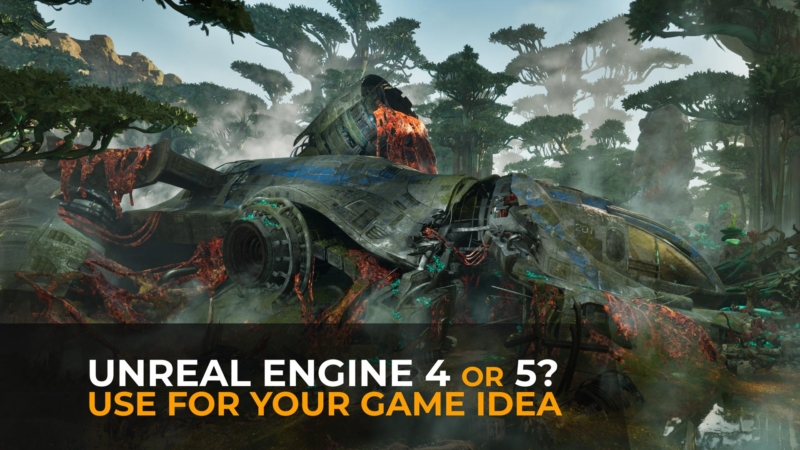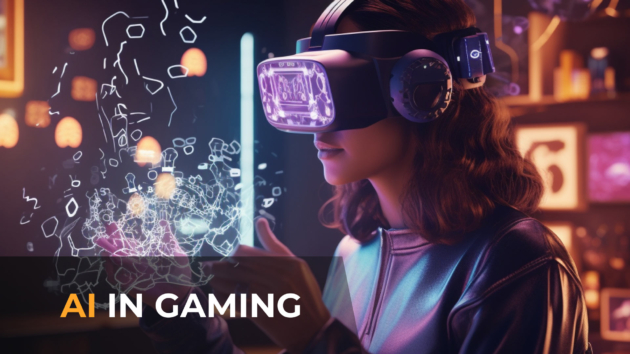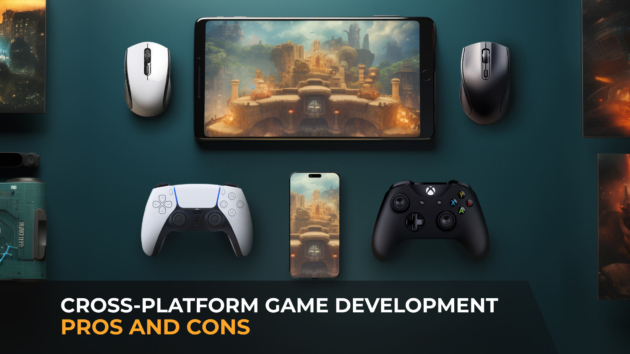Unreal Engine 5 (UE5) has emerged as a transformative force in game engineering.
It has introduced groundbreaking advancements that redefine the possibilities for visual storytelling, gameplay experiences, and overall development efficiency. While the technical prowess of the engine has been widely discussed, it also offers solid benefits for game publishers.
What’s the Key Difference Between Unreal Engine 4 and 5
As a company with years of experience in Unreal game development, creating immersive titles for mobile, console, and PC platforms, we closely monitor the engine’s changes and advancements. In this article, we will discuss in detail the features that make UE5 stand out and compare its features to those of its predecessor, Unreal Engine 4.
UE4 vs UE5 comparison: let’s get into it.
Visual Fidelity: Captivating Players with Photorealistic Worlds
Unreal Engine 5’s ability to render breathtakingly realistic environments and characters is a game-changer. With our extensive expertise in custom game development, we can assert with certainty that UE5’s Nanite, a powerful micropolygon rendering system, is an extremely effective tool that allows engineers to effortlessly create vast, intricate worlds without compromising performance.
This breakthrough technology eliminates the need for manual baking, which often imposes limitations on detail and complexity. Through Nanite, we can seamlessly stream high-resolution assets into scenes, constructing intricate landscapes, detailed architectural structures, and lifelike characters without sacrificing visual fidelity in the slightest.
While Unreal Engine 4 has made significant strides in visual fidelity, the latest version of Unreal takes it to a whole new level with Nanite’s ability to handle vast amounts of high-resolution assets. This capability opens up a world of possibilities for creating incredibly detailed and photorealistic environments and characters that were previously unattainable. In contrast, Unreal 4, while a powerful engine in its own right, has limitations in handling high-poly assets, often necessitating manual baking, which can be time-consuming and limit the achievable level of detail. This difference in fidelity capabilities makes the latest version of Unreal the clear choice for those primarily focused on creating ultra-immersive and visually stunning gaming experiences.
Lumen: Dynamic Lighting for Unparalleled Immersion
UE4’s lighting system is robust, but it requires pre-baked calculations, which can lead to inconsistencies and somewhat limit the degree of realism. In comparison, Lumen, UE5’s dynamic global illumination system calculates lighting in real-time, reacts to changes in the scene, and produces stunning visuals that help immerse players in the game world.
Lumen’s dynamic nature also enables developers to create lighting that reacts seamlessly to the player’s actions and the environment. This revolutionary lighting technology sets a new standard for video games, allowing developers to push the boundaries of immersion in PC, console, and mobile game development.
Streamlined Development: Optimizing Productivity and Reducing Costs
While Unreal 4 has made significant progress in streamlining the development process, Unreal Engine 5’s introduction of World Partition elevates it even further. World Partition is a sophisticated level streaming system that divides large, expansive worlds into smaller, more manageable chunks.
This innovative approach eliminates loading delays and improves overall performance, particularly for open-world games. With World Partition, we can create vast and highly detailed environments without compromising the gameplay experience.
Unlike Unreal Engine 4’s traditional level streaming, which can sometimes lead to abrupt transitions between levels and performance hiccups, World Partition’s changes are always seamless, ensuring a smooth and uninterrupted game flow. These improved performance and reduced loading times enable developers to focus more on creating engaging content rather than worrying about optimizing performance.
Virtual Shadow Maps (VSMR) and Temporal Super Resolution (TSR)
Unreal Engine 5 introduces several additional features on top of those present in the previous version that further enhance the visual appeal of games while optimizing performance. VSMR, for example, combines high-resolution and low-resolution shadows to provide a more detailed and realistic shadow effect without the performance overhead of traditional high-resolution shadows.
TSR is an advanced anti-aliasing technique that delivers higher image quality with minimal artifacts. This innovative feature allows us to render higher-resolution textures at a lower resolution, reducing rendering costs while maintaining visual fidelity.
These features solidify Unreal 5’s ability to create stunning scenery and immerse players in the game. They provide developers with powerful tools to create games that are both visually impressive and efficient.
Enriching the Player Experience: Creating Captivating and Immersive Gameplay
So, the combination of Nanite and Lumen in Unreal Engine 5 can create unparalleled photorealistic environments that truly transport players into the artificial world. Lumen’s real-time lighting dynamically reflects the player’s actions and movements, adding a layer of dynamism and authenticity that UE4’s pre-baked lighting often struggles with.
But that’s not all. Unreal 5 also introduces features like Niagara, a powerful particle system that enables engineers to create stunning visual effects like dynamic weather systems and explosive spellcasting. In comparison, Unreal 4’s particle system can sometimes feel limited, particularly for complex effects. This increased visual dynamism can significantly enhance the player experience and make the gameplay memorable.
Audio Occlusion and Obstruction: Enhancing Soundscapes for Spatial Awareness
Similar to visuals, the latest iteration of Unreal elevates the player’s auditory experience with its advanced audio occlusion and obstruction system. Sounds are accurately positioned and muffled when obstructed by objects, adding a layer of realism that’s lacking in Unreal Engine 4.
While Unreal Engine 4 offers basic audio occlusion, it can be inconsistent and often struggles with complex environments. Unreal Engine 5’s system significantly improves upon this, adding another layer of engagement and realism to the gameplay experience.
Commercial Success: Attracting Wider Audiences and Driving Sales
The visual and gameplay advancements of Unreal 5 can undoubtedly translate into commercial success. Nanite and Lumen enable us to produce stunning visuals that attract a wider audience and raise the bar for graphical fidelity in gaming.
However, Unreal Engine 4 shouldn’t be underestimated. Its vast library of free and paid assets, established workflow, and familiarity among developers can still make it a cost-effective and efficient choice for certain projects. Additionally, mature engines like UE4 typically have fewer bugs and compatibility issues, which can be crucial for some publishers.
Ultimately, the choice between UE4 and UE5 depends on the specific needs and resources of the development team. For those seeking to create cutting-edge, visually striking, and immersive experiences, the latest interaction of the engine offers unprecedented potential. However, Unreal 4 remains a robust and reliable option for projects where cost-effectiveness, stability, and a familiar workflow are crucial.
Other Features Worth Mentioning When Comparing Unreal 4 vs Unreal 5
PCG (Procedural Content Generation). PCG is a set of tools and techniques for automatically generating game content, such as terrain, dungeons, and enemies. UE5’s PCG instruments make it easier to create vast and varied worlds with greater efficiency, reducing the amount of manual work required and allowing us to focus on more creative aspects of game development.
MetaHuman Creator. MetaHuman Creator is a Unreal 5’s tool for creating high-fidelity 3D characters in a matter of minutes. It eliminates the need for traditional character modeling and rigging, allowing developers to create diverse and realistic characters quickly and easily.
Unreal Engine 5 vs 4 Comparison: Concluding Words
In conclusion, Unreal Engine 5 represents a significant leap forward in game engine technology, offering a vast array of advancements that empower developers to create truly immersive and groundbreaking experiences. Its advanced features, such as Nanite, Lumen, Niagara, PCG, and MetaHuman Creator, have the potential to revolutionize the way games are developed and played.
While Unreal Engine 4 remains a viable choice for many developers due to its maturity, stability, and extensive asset library, the latest version is poised to set a new standard for game development, offering developers the tools and technologies they need to create a completely new breed of visually stunning, and engaging games.
Elevate your gaming experience with our unparalleled Unreal game development services. Specializing in both UE4 and the cutting-edge UE5, we harness the most sophisticated and advanced technologies to bring your vision to life. Whether you crave the innovative features of UE5 or require the stability of the older UE4, we are here to craft extraordinary gaming solutions tailored to your needs.




